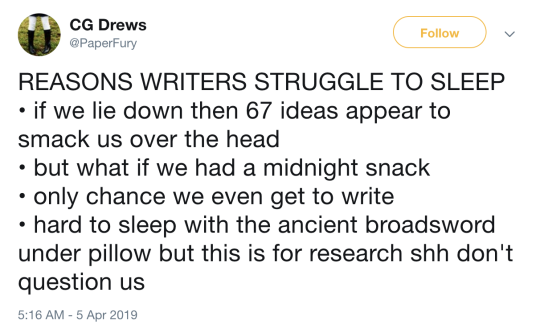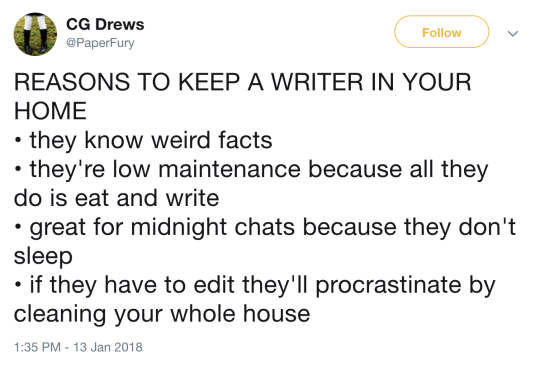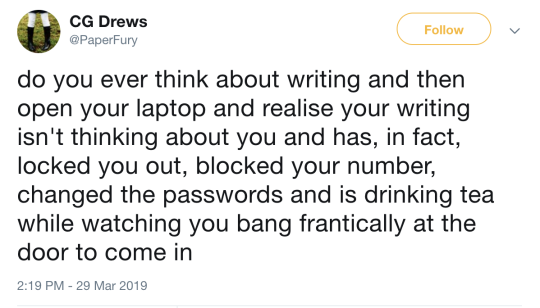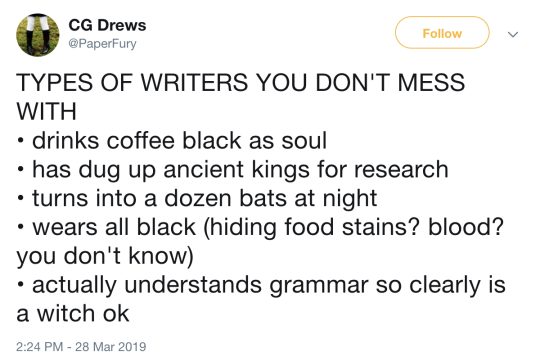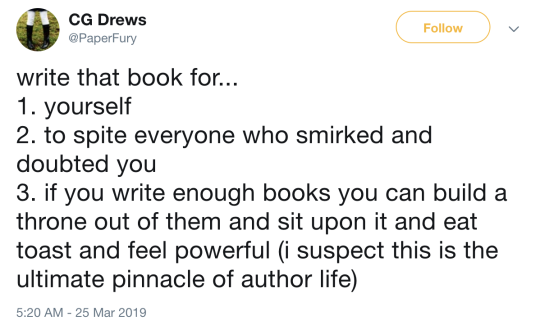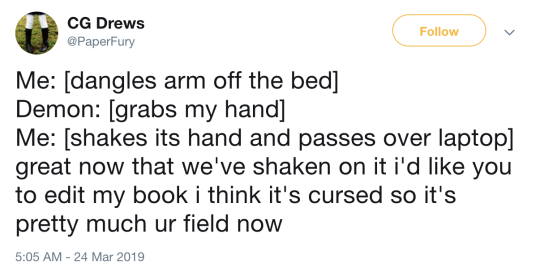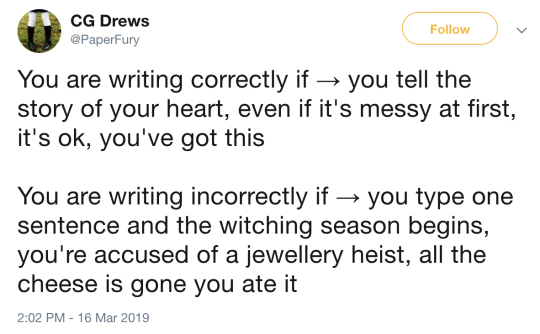18•infj•writer•reader•literary technique enthusiast•aspiring scientific journalist/fiction writer•current wip(s): The Clockworker & the Therians series
Don't wanna be here? Send us removal request.
Text
“He had a lecture prepared for me, as he always did. It was a lecture he had given to me before—but if you’re not repeating yourself by the end of your life, you haven’t yet figured out what’s true.”
—Melinda Gates, The Moment of Lift
#quotes#inspiring quotes#books#book quotes#inspirational quotes#melinda gates#feminism#female empowerment#the moment of lift
7 notes
·
View notes
Text
when things are difficult for your otp but then you remember they’re at least both alive
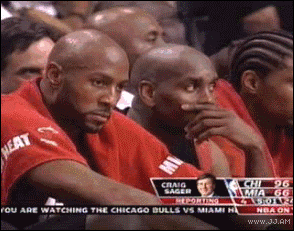
49K notes
·
View notes
Text
Mastering Midpoints (The Saviors of Saggy Story Middles)
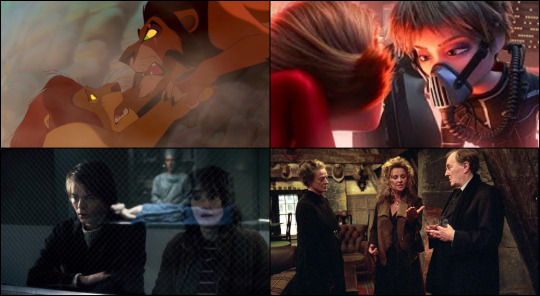
I’ve been pulling my hair out lately trying to fix the middle part of one of my novels, and one of the main problems with it, relates to the midpoint. You see, I plotted and largely wrote this manuscript years ago, before I had an in-depth understanding of story structure–like a lot of us have probably done. Heck, a lot of us don’t even like thinking about story structure because it feels too restrictive and formulaic, and that’s fine. But whether you plot your stories’ structures by the books or just do what you want as you go, understanding story structure can be hecka important. And even if you hate it, at least knowing how it functions can be super useful, especially if you are trying to troubleshoot what is wrong with a manuscript, like I was weeks (months?) ago.
Once I realized that my problem related to the midpoint, I was able to begin brainstorming (and praying) how I might fix it. And a lot of times, the midpoint is key in doctoring a problematic middle. I kind of like to think of it as the savior.
The midpoint typically happens in the middle of the plot (no surprise there). It is the moment when new, significant information–or at least a shift in context–enters and turns the story in a different direction.
(Wow, is that definition vague enough?)
Now, the direction of the story can change completely, like a 180, or it may be very slight and subtle, more like 10 degrees, but it changes in a significant way.
Most often, in a typical story structure, the change is this:
The protagonist moves from being primarily responsive to being more (pro)active, in regards to the main plot.
So, it’s usually like:
Character responding to problems –> Midpoint (new information or context) –> Character being proactive toward main problems.
The “new information” is just something that allows the character (or audience) to have a greater understanding of what’s going on, so that they can now be more active in attacking the problem.
There are literally so many ways this can play out, which is why the midpoint can seem difficult to grasp, so I’m going to grab some popular examples:
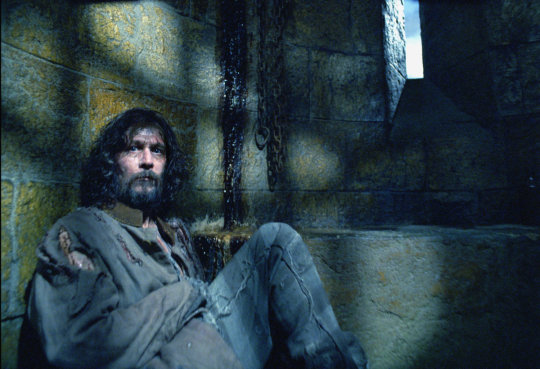
In Harry Potter and the Prisoner of Azkaban, the midpoint happens when Harry overhears the professors in the Three Broomsticks and learns Sirius Black is the reason his parents are dead.
Why? Because prior to this, he is responding or reacting to the fact Sirius is after him. But after this, he wants to seek revenge on Sirius, in other words, mentally, he becomes active in “attack mode.”
In Legally Blonde, the midpoint happens when Elle realizes that she will never be good enough for Warner.
Why? Because prior to this, she is just responding to Warner’s breakup. But after this she is actively trying to succeed at Harvard, with an intensity she hasn’t had prior–she buys all new materials, studies hard, answers questions in classes.
In Interstellar, the midpoint happens when Cooper, Murph, and by extension, the audience, realize that there is no real “Plan A”–everyone on Earth is going to die.
Why? Because prior to this, Cooper is responding to the destiny of humankind, but after this, he goes into an active “attack mode” by planning to do whatever it takes to return to Murph and Earth right away.
In Ralph Breaks the Internet, the midpoint is when Ralph realizes he can get the money they need from making viral videos.
Why? Because prior to this, he is unsuccessfully responding to the broken steering situation and the internet itself, and after this, he hatches a solid plan to get the cash, with a better understanding of how the internet works.

But a midpoint can be rather loose, which is why it’s hard to define and wrap our minds around. For example, I may use terms like “respond” and “reaction” paired with “attack” and “pro-action,” but you could argue from another perspective, some protagonists are doing all of them all the time. For example, from the inciting incident, Ralph is trying to actively solve a problem, and same goes for Cooper. But here’s the thing. At the midpoint, new information or a new understanding allows them to “attack,” better or more accurately, the focal conflict.
Think of it as a moment that jump-starts the protagonist into a different direction.
In some cases, this may be a rather unexpected direction.
In Lion King, Simba spends the first part of the story reacting to the fact he will someday be king, but then the midpoint hits–Mufasa dies and Scar tells Simba no one will ever love or forgive him–Simba goes into an “attack” mode of sorts, except his is that rather than just responding to being king someday, he proactively chooses to never be king, and takes action by running away and starting a new life. It relates to the main conflict of the story, but his “attack mode” is to actively, intentionally, run away. After all, he thinks he is the problem, so in a sense, he is “attacking” himself.
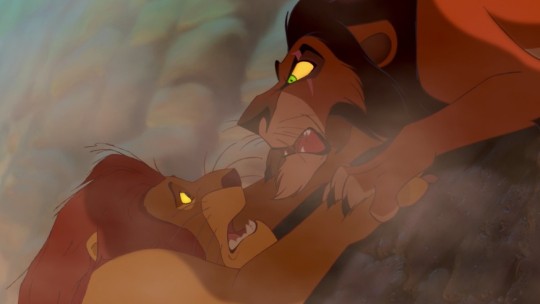
The content of a midpoint can be very flexible, as you can see from these examples. If you want to get a better discerning eye for what a midpoint is and how many different forms it can take, start pausing movies smack dab in the middle–there should be something around there that enters the story and pushes it in a new direction. You can also try opening books to the middle and searching around there. Harry discovering Sirius is responsible for his parents’ deaths is near the middle. In Stranger Things season one, Will’s body is found smack dab in the middle, which is new information that changes context, and therefore the direction of the story. And after that point, the characters have to all decide how to act next.
So now that we have some idea of what a midpoint is (significant information that changes the direction of the story, usually by changing the protagonist), let’s talk about how it actually works.
Step One: New Significant Information Enters …
In order for a story or protagonist to start going a new direction, there has to be something that causes that. Information. Or an event that is new information.
Or at least a shift in our understanding of the information we already have (context shift), which in a sense, is its own kind of “new” information.
Keep reading
882 notes
·
View notes
Text
“O hushed October morning mild, Begin the hours of this day slow. Make the day seem to us less brief.”
— Robert Frost, from “October” (via theclassicsreader)
2K notes
·
View notes
Text
College Application: Do you have any history of crime?
Me: My library book is currently five days overdue I’m so sorry
0 notes
Text
If there’s a male character I care about (when I’m writing), there’s like a 50% greater chance of him crying at some point because in this house, we support normalizing men and boys being emotionally expressive and vulnerable and we will never shame them for it
27K notes
·
View notes
Text
Me, coming back to my WIP after not writing for months: I hope I’m still welcome here
My characters, who I endlessly torture: Bold of you to assume you were ever welcome here
7K notes
·
View notes
Text
Me while editing: *adds a sentence*
*finds nearly identical sentence in the next paragraph*

102K notes
·
View notes
Text
me jumping between my WIPs without actually finishing any of them
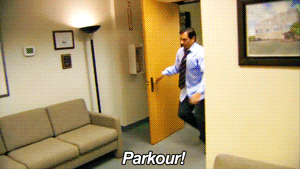
40K notes
·
View notes
Text
“Sometimes you’ve got to do what you think is right and damn the consequences.”
—Morgana Pendragon, Merlin
#quotes#tv quotes#merlin#merlin bbc#morgana#morgana pendragon#merlin quotes#inspiring quotes#inspirational quotes#king arthur#king arthur quotes
26 notes
·
View notes
Text
how we act alone when we don’t feel like we have witnesses.. that is the genuine self.. me walking around my room punching the air talking to myself in a bad southern accent, that’s ME baby. you’re never going to know me like i know me. haha.
310K notes
·
View notes
Text
My Character: Hey what’s up?
Me: *reads one sentence from Pride and Prejudice*
My Characters: How beist thou on this fine morning?
watching tv or generally consuming media that’s set a significant amount of time in the past really messes with the way I write dialogue. my sentence structure’s level of pretentiousness shoots up like 3000%. my characters’ vocabularies triple. people take four times longer to say the things they want to say. everyone is suddenly preoccupied with not dying from the plague
313 notes
·
View notes
Text
Reading Like a Writer
One of the most common pieces of writing advice is to read. Important, but vague. An easy way to analyze novels to become a better writer is to sort what you read into what you don’t like and what you do like. Spend some time thinking–whether alone, in writing, or through conversation–about what makes you like or dislike the writing, and brainstorm ways that the writing could have been improved or changed.
Here are some possible dislikes and likes that you might notice when reading:
What You Don’t Like:
Boring spots that you skim through
Unnecessary scenes that don’t advance the plot
Confusing sub-plots
Chunky dialogue
Characters acting outside their character
Poorly done tropes
Too much telling, not enough showing
Too much showing, not enough telling
Overly flowery prose
Big words for the sake of big words
One-dimensional villains
Lack of distinctive voices
What You Do Like:
Twists on tropes
Scenes where you felt like you were a part of that world
Characters you think about after the book ends
Clever plot twists
Good information reveal
Villains and antagonists that keep you on your toes
Characters that know what they want
Characters forced to make sacrifices
Side-characters that have personalities of their own
Scenes so intense that you find yourself peeking at the next page
Protagonists with flaws that hold them back
Scenes where you felt the emotions conveyed
13K notes
·
View notes
Text
You and I have very different definitions of terrible
Terrible Character Ideas:
A monk based on a European Christian archetype. They have sworn a sacred oath to defeat the giant snail plaguing the countryside.
A dragonborn desperately trying to convince the party that they’re really an aarakocra with a skin condition that made their feathers fall out.
Your standard horny bard, but they play a washboard.
A sentient hat piloting a mannequin.
A dark elf who’s afraid of the dark, and terrified of spiders.
A peasant farmer who joined the adventure because they’re going through a midlife crisis and want to ~find themself.~
A druid who got involved because they’re the party’s weed dealer.
A werewolf who doesn’t believe in the moon.
112K notes
·
View notes
Text
Fellow Writeblrs Reblog if you're down to get tagged!
So I can tag you hehe!
188 notes
·
View notes
Text
“And here therefore, I sing my songs and tell my stories. For folks need songs, they need such stories. Without the tales we build and tell, we’ve naught to put our needs and natures to, naught to hold us back from being lost.”
—Sheelagh Russel-Brown, A Mainland Mansie Meur
10 notes
·
View notes
